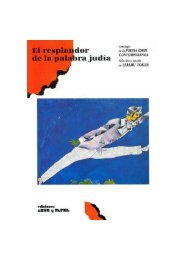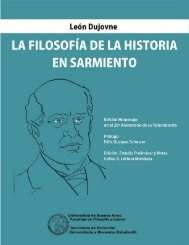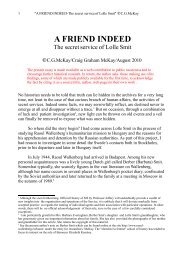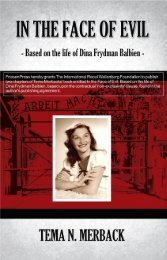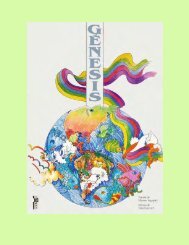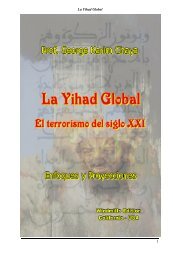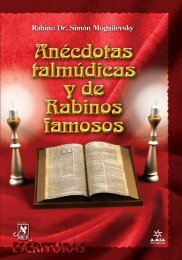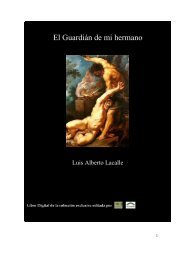Speaking to One Another - The International Raoul Wallenberg ...
Speaking to One Another - The International Raoul Wallenberg ...
Speaking to One Another - The International Raoul Wallenberg ...
- No tags were found...
You also want an ePaper? Increase the reach of your titles
YUMPU automatically turns print PDFs into web optimized ePapers that Google loves.
tern of the number 40 1 is a direct manifestation of linguistic thinking and is the way of social representationof the phenomena by our narra<strong>to</strong>rs. However one of our respondents directly linked this number<strong>to</strong> memories. Almast Haroutyunian’s mother, who was six years old during the time of fleeing, later<strong>to</strong>ld her daughter how she, <strong>to</strong>gether with her mother and younger sister, were hiding at daytime in thefields and pastures for forty days, coming out at nights <strong>to</strong> gather some edible plants. “My mother tells me,we stayed for forty days. I asked her – “Mom, how do you know it was forty”? She replied “they slaughtered us onthe 14 th ; wheat was already ripe... I am telling it approximately.” If the number 40 is a linguistic pattern, thenmost probably it comes from the vocabulary of the initial narra<strong>to</strong>rs and it has passed <strong>to</strong> the next generationspreserving its form.We think that the tendency of linking personal s<strong>to</strong>ries of their families <strong>to</strong> major political events is alsothe result of the impact of subsequent social memories, and the actual participants of the “events” probablyperceived this differently. For example, some people remember from their parents’ s<strong>to</strong>ries, howrepresentatives of foreign embassies were looking out of their office windows, watching the massacresand deportation of Armenians while “it was them who were encouraging the genocide.” In particular,the alleged involvement of Germans in massacres of Armenians is perceived as a memory (“At the age of17 Turks <strong>to</strong>ok my father, who was from Afionkaraisar, <strong>to</strong> work at the construction of the Baghdad railway. Constructionwas managed by Germans and he was one of those few people who didn’t die from starvation and laterhe fled <strong>to</strong> Baghdad. Germans just watched people die of starvation. My father always used <strong>to</strong> say that Germans are<strong>to</strong> blame, they were standing behind Turks,”-from the interview with Hamestuhi Avagyan).Sometimes, however, especially when remembering instances of assistance, characters are being personifiedmore specifically. Avetis Keshishian remembers up <strong>to</strong> this day that the name of the Turkish policeman,who helped with his father’s escape, was “Ismail Chaush”; although his father met this policemanonly briefly. Vasak Toroyan talks about a Kurdish guy named Maleh, who helped their whole village;Almast Haroutyunian remembers up <strong>to</strong> this day the name of the young Kurdish woman, Taveh,who helped her mother when she was a kid; Arpik Shahinyan remembers the name of a Turkish servantKneh who used <strong>to</strong> once serve at her grandfather’s house, and rescued her uncle.Through family memories our respondent were reviving their biography and the his<strong>to</strong>ry of their ances<strong>to</strong>rs.However, the biography of many respondents was not only based on the tragic past of their forbearers,which is quite natural. Even in the life of the third generation the past of their ances<strong>to</strong>rs was<strong>to</strong> a certain extent “present.” <strong>One</strong> of the most explicit manifestations of this phenomenon is telling thes<strong>to</strong>ries related <strong>to</strong> the past of their relatives using the present tense. <strong>The</strong> narrative structure of most ofour respondents presupposes that they were personally witnessing those events: “My grandma comesand says...” ; “My aunt was the cook in that man’s, that Turk’s house and she <strong>to</strong>ok the kid <strong>to</strong> his place...”“<strong>The</strong>y bring those people and cram them in<strong>to</strong> the shed....” This type of wording creates an impression1 <strong>The</strong> number 40 appears in various styles of Armenian folklore, in the Armenian epos, fairy tales, songs, etc and is most probablyrooted in biblical vocabulary.102







